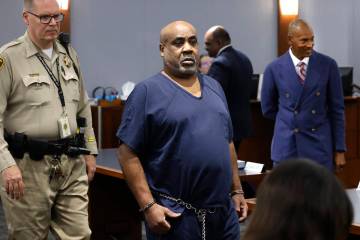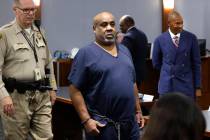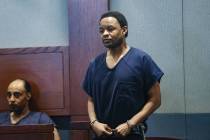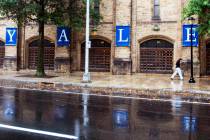Part III: A City In Full
This is the last of three special sections published by the Review-Journal to mark the millennium and the end of the century that brought Las Vegas into being. It has been one of the most labor-intensive projects the Review-Journal has ever undertaken, occupying two writer-editors full-time for well over a year, with contributions by others.
The newapaper's motive was to document the community's formative years while memory is still relatively fresh.
"Las Vegas is unusual in that it was created entirely in the 20th century," Publisher Sherman R. Frederick noted in announcing The First 100 project in March 1998. "Many of those who made the important decisions remain alive, while immediate relatives and close acquaintances of others still survive. This gives the Review-Journal a special opportunity to portray them and their accomplishments with authentic detail, which newspapers and historians in other cities would envy."
With that, the Review-Journal committed its staff to a 17-month effort to tell Las Vegas' story with in-depth profiles of 100 colorful men and women who left their marks in Southern Nevada. Special Projects Editor A.D. Hopkins and writer K.J. Evans, both experienced writers of history, were assigned to the project full time.
KLVX-TV, Channel 10, the educational television station for Las Vegas, joined with the Review-Journal in the effort.
Part I: The Early Years, published in February, dealt with those who made history from the valley's discovery by explorers until about the onset of World War II. Part III: A City In Full, was published in May, profiling people who were most active from the 1940s into the late '60s. Today's section, Part III: A City In Full, brings the story up to date.
Those in the first section were already dead by the time this project began, but in many cases the Review-Journal was able to find and interview their aging children or people who knew them well. Publication of those stories caused some relatives and friends of those people, previously unknown to journalists and historians, to come forward. Some of those brought with them troves of historic photos, documents, and artifacts, and were referred to the photo archive at UNLV Special Collections, or to the Nevada State Museum. One important historical story already has been published in the Review-Journal, and others are expected, as a result.
Some of those profiled in the second and third section are still alive, and whenever feasible the Review-Journal writers captured their memories on tape to be deposited in oral history archives at UNLV Special Collections.
Living members of The First 100 will be honored at a black-tie, invitation-only banquet Dec. 3 at the MGM Grand Hotel. Proceeds of the banquet will benefit Channel 10 and a children's charity to be announced later. Gov. Kenny Guinn will welcome the guests.
Nominations for inclusion in The First 100 were solicited from Review-Journal readers as well as journalists and historians. More than 300 people were nominated, and valid arguments could be made for nearly every one.
Time and resources limited the number profiled to 100 people, so some 200 were passed over, many of them quite as important and interesting as those profiled. Editors decided to bypass a few especially important people, whose contributions already have been acknowledged, to write about subjects who never before had their share of credit. Glaring omissions were the price of varied and fresh content.
Because such choices were necessary, the Review-Journal does not represent that the 100 chosen are the most important who could have been selected, only that they were significant and interesting. Nor did the editors attempt to rank their importance; they are organized in approximate chronological order of the events in which they played central roles.
Hopkins and Evans are both former editors of Nevadan, a Review-Journal Sunday magazine that specialized in historical pieces and in-depth profiles. Hopkins also asked certain local historians and some of the Review-Journal's star writers to contribute stories.
Historical consultants for the project were Robert Faiss, former city editor of the Las Vegas Sun and now an attorney specializing in gaming law; Michael Green, a history teacher at Community College of Southern Nevada; Eugene Moehring, a history teacher at UNLV and author of a respected history of Las Vegas; Frank Wright, curator at the Nevada State Museum & Historical Society; and W.V. "Bill" Wright, former chairman of the museum's board.
W.V. Wright, who was better known for many years as general manager of the Review-Journal until his retirement in 1981, died in August after a short illness. He continued his involvement with The First 100 until a few weeks before his death.
Others who were greatly helpful to the project included the staffs of UNLV Special Collections and the Nevada State Museum & Historical Society; historian Elizabeth Warren; and Joanne L. Goodwin, an oral history teacher at UNLV.
The cover, graphics and page layouts were designed by Ched Whitney.
All three sections of The First 100 will be condensed into one coffee-table book, published by Huntington Press in November, in time for Christmas giving.
This hardbound book can be ordered now at substantial pre-publication savings. Details and an order form are on page 19 of this section.
Huntington Press has published a number of well-designed and popular books about Las Vegas including "On The Boulevard," a collection of columns by John L. Smith, originally published in the Review-Journal.
AUTHORS
A.D. Hopkins, editor of The First 100 project, is a 30-year resident of Las Vegas and for 12 years edited Nevadan, the Sunday magazine formerly published by the Review-Journal, which frequently explored the sort of community history chronicled here. At the Review-Journal, he is special projects editor, which involves in-depth hard news reporting.
Kenneth J. Evans was a lifelong resident of Nevada, grew up in North Las Vegas, and graduated from the University of Nevada, Reno in 1982 with a degree in journalism. He was a reporter and editor at several rural Nevada newspapers, and was the editor of Nevadan, the Sunday magazine formerly published by the Review-Journal. In 1992, Evans was appointed media relations manager for the Nevada Commission on Tourism, where he served until returning to the Review-Journal early last year to work on The First 100 project.
Dick Benoit is a publicity coordinator and speech instructor at UNLV. A 26-year U.S. Navy and Air Force veteran, he served as a public affairs officer for Nellis Air Force Base from 1984 to 1987. He is presently a lieutenant colonel in the Air Force Reserve.
Review-Journal columnist John L. Smith is a native Nevadan with family roots dating back to 1881. His most recent books are "Las Vegas Boulevard," a column collection, and "The Animal in Hollywood," a biography of Mafia figure Anthony Fiato. In 1998, Smith was honored for column writing by the National Headliner Awards and also was named Outstanding Journalist by the Nevada Press Association. But he says he'd gladly trade the awards for an interview with Moe Dalitz.
Award-winning entertainment columnist/critic and food writer Michael Paskevich joined the Review-Journal in 1989 and is considered Las Vegas' toughest entertainment critic. In addition to his R-J columns, he is writing a book about the oddities of covering "The Entertainment Capital of the World."
Ed Vogel has been with the Review-Journal 22 years and its capital bureau chief in Carson City since 1985. He is a graduate of the University of Michigan. He is married to Carol Vogel, columnist for the Reno Gazette-Journal.




























